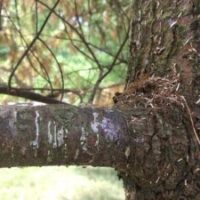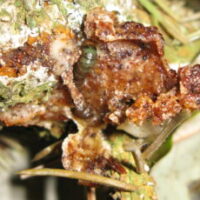 Purdue University - Extension - Forestry and Natural Resources
Purdue University - Extension - Forestry and Natural Resources
Got Nature? Blog
Purdue Landscape Report: Trees stressed by prolonged drought are more subject to attack by boring insects. This article provides tips and a video link on how to manage pines for borers.
Record breaking heat and sporadic rainfall during July of 2023 took their toll on landscape trees. Cone bearing evergreens, like white pines, are especially susceptible to drought and flooding. These environmental stresses reduce the ability of trees to defend themselves against boring insects. To make matters even worse, insect borers use their keen sense of smell to guide them to these stressed trees. Trees often take several years to recover from drought. Monitoring trees for early signs of decline is critical to a successful management program.
Early intervention can help you keep infested trees from becoming a breeding ground for borers that can destroy an entire planting. Trees that are more than half dead, or those whose needles are mostly yellow are usually too damaged to save. Removing these trees in late fall and winter removes the reproducing borers from the landscape before borers they can emerge to attack healthy trees. As an extra protective measure, insecticides can be applied on to the trunk to kill boring insects chewing into or out of the trees. Apparently healthy trees located near borer-infested trees can also benefit from a soil applied insecticides, like imidacloprid or dinotefuran applied in fall and early spring.

Figure 2. Fine powdery sawdust left by bark beetles and fine shavings of sawyer beetles are signs that a tree may already be too damaged to save.
Zimmerman pine moth (ZPM)commonly attacks pine trees in late July. Adult female moths lay eggs at the junction of tree branches and the trunk and winters in cracks and crevices. In early spring, when forsythia bloom, larvae bore inside the trunk and can girdle and kill branches and trees leaders. These are the two times of year that this borer is most susceptible to insecticides. Note soil applied imidacloprid is not particularly effective against ZPM. Spruces and most pines are susceptible to this borer.
To view this full article and other Purdue Landscape Report articles, please visit Purdue Landscape Report.
Subscribe and receive the newsletter: Purdue Landscape Report Newsletter.
Resources:
Borers of Pines and Other Needle Bearing Evergreens in Landscapes, The Education Store
Normal Needle Drop: Even Healthy Evergreens are not Evergreen, Purdue Landscape Report
White Pine Decline in Indiana
Tree Defect Identification, The Education Store
Tree wounds and healing, Got Nature? Blog
Tree Risk Management, The Education Store
Why Is My Tree Dying?, The Education Store
Managing the Zimmerman Pine Moth, The Education Store
The Woody Plant Seed Manual, U.S. Forest Service
Native Trees of the Midwest, The Education Store
Investing in Indiana Woodlands, The Education Store
Forest Improvement Handbook, The Education Store
Find an Arborist, International Society of Arboriculture
Subscribe Purdue Extension-Forestry and Natural Resources YouTube Channel
Cliff Sadof, Professor, Ornamental, Pest Management
Purdue Entomology Extension Coordinator

Recent Posts
- ID That Tree: Learn to Identify Hoptree/Wafer Ash
Posted: October 30, 2024 in Forestry, Forests and Street Trees, How To, Urban Forestry, Wildlife - Publication – Handbook on Processing Fish for Small-Scale Fish Farmers
Posted: October 17, 2024 in Aquaculture/Fish, Aquatic/Aquaculture Resources, How To, Publication, Wildlife - When Roundup Isn’t Roundup – Purdue Landscape Report
Posted: in Forestry, Gardening, Plants, Urban Forestry - American Citizen Planner – Indiana Program Celebrating 4 Years of Impact
Posted: October 16, 2024 in Community Development, Land Use - IN DNR Deer Updates – Epizootic Hemorrhagic Disease Detected in Several Areas in Indiana
Posted: in Alert, Disease, Forestry, How To, Wildlife, Woodlands - Black Spot of Elm – Purdue Landscape Report
Posted: October 15, 2024 in Urban Forestry, Wildlife, Woodlands - Economics and Aquaculture Expert Kwamena Quagrainie is Featured Specialist in ANR Newsletter
Posted: in Aquatic/Aquaculture Resources, Great Lakes - Opportunity for Funding Available for Landowners, SISL Partnership
Posted: October 14, 2024 in Forestry, How To, Woodlands - New Threat to North American Elms – Purdue Landscape Report
Posted: October 12, 2024 in Forestry, Invasive Insects, Wildlife, Woodlands - Is Fall Foliage due to Seasonal Change or Heat Waves?
Posted: October 11, 2024 in Forestry, Forests and Street Trees, Urban Forestry, Wildlife, Woodlands
Archives
Categories
- Alert
- Aquaculture/Fish
- Aquatic/Aquaculture Resources
- Ask the Expert
- Christmas Trees
- Community Development
- Disease
- Drought
- Forestry
- Forests and Street Trees
- Gardening
- Got Nature for Kids
- Great Lakes
- How To
- Invasive Animal Species
- Invasive Insects
- Invasive Plant Species
- Land Use
- Natural Resource Planning
- Nature of Teaching
- Plants
- Podcasts
- Ponds
- Publication
- Safety
- Spiders
- Timber Marketing
- Uncategorized
- Urban Forestry
- Webinar
- Wildlife
- Wood Products/Manufacturing
- Woodland Management Moment
- Woodlands

